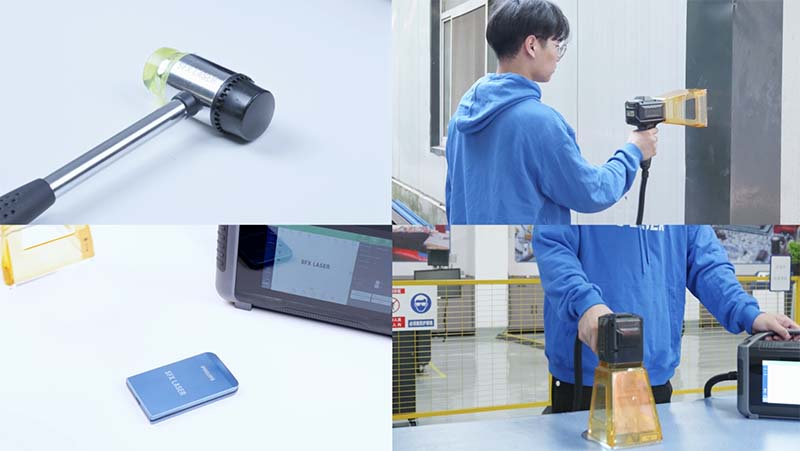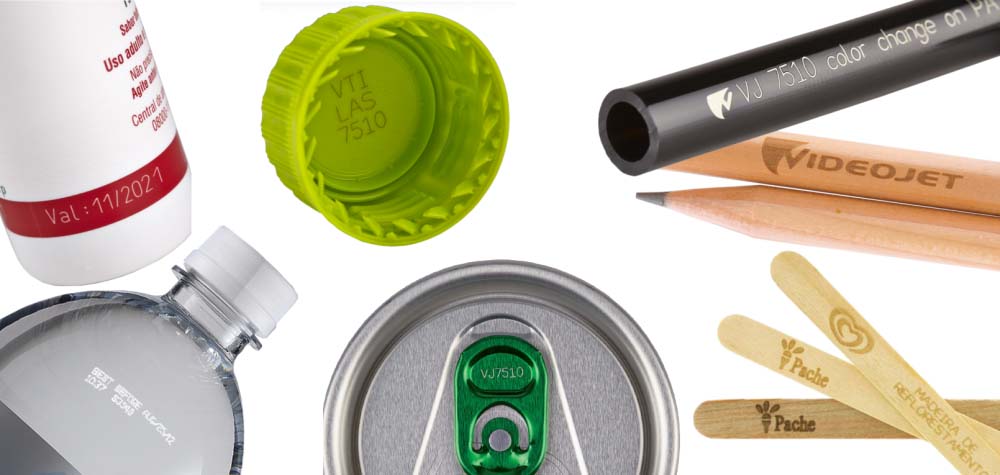Which laser marking machine should you buy in 2025? Before making a purchase, it’s crucial to clearly define your marking objectives: What type of product are you marking? What kind of marking effect do you need—deep engraving, high contrast, or fine detail? What is the material of your product—metal, plastic, or something else? By understanding your specific needs, you can confidently select the best laser marking machine tailored to your application.
Classified by Engraving Material – Metal Laser Marking Machines
Metal laser marking machines are designed specifically for marking and engraving on metal surfaces. These applications demand high precision due to the hardness and reflective nature of metal materials.
Fiber Laser Marking Machine
Recommendation: ★★★★★
This type of laser marking machine for metal uses a fiber laser source, delivering high beam quality at a wavelength of 1064 nm. It features an exceptionally long service life of up to 100,000 hours and achieves an electro-optical conversion efficiency of over 28%. Compared to other laser marking machines, it offers faster marking speeds, finer detail, minimal thermal impact, and superior engraving precision. It supports deep engraving, high-resolution graphics, and intricate pattern processing with excellent efficiency.
Typical Applications:
Widely used across industries such as electronics, hardware, precision tools, semiconductors, telecommunications, medical devices, automotive components, consumer electronics (3C), and decorative products. Suitable for marking metals, plastics (including PVC), and other commonly used industrial materials.
Fiber laser marking machines, semiconductor (diode-pumped) laser marking machines, and ultraviolet (UV) laser marking machines are all suitable options depending on the specific application needs and material types.

Non-Metal Laser Marking Machine
Non-metal laser marking machines are suitable for a wide range of non-metal materials, including paper, fabric, plastic, resin, wood, leather, quartz, glass, rubber, ceramics, and acrylic. Common technologies include CO₂ laser and UV laser systems. Fiber laser systems can also mark certain non-metal materials.
UV Laser Marking Machine
Recommendation: ★★★★☆
UV laser marking machines are equipped with deep ultraviolet lasers and high-speed galvanometer scanning systems. Featuring an extremely small focused spot and minimal heat-affected zone, they are ideal for ultra-precise marking and for heat-sensitive materials such as polypropylene (PP) or thin film plastics. UV laser marking systems are the preferred choice for users who demand high precision and fine detail. Key advantages include high electro-optical conversion efficiency, long service life of nonlinear crystals, stable system performance, high positioning accuracy, high productivity, and modular design for easy installation and maintenance. The price of UV laser marking machines is relatively high, usually several times the price of fiber laser marking machines.

CO₂ Laser Marking Machine
Recommendation: ★★★☆☆
The CO₂ laser marking machine uses carbon dioxide gas as the laser medium and is equipped with a high-speed galvanometer scanning system and control software. Operating at a typical wavelength of 10.6μm in the mid-infrared range, it is well-suited for marking and engraving most non-metal materials. It is widely used on wood, leather, paper, fabric, plastics (such as PET, PE, and PVC), stone, and rubber. Common applications include packaging, garment manufacturing, beverage bottle coding, leather goods processing, and crafts.
Its main advantages are lower cost, ease of operation, and broad material compatibility. However, it offers lower precision and fine-detail performance compared to UV or fiber laser marking machines and is not suitable for deep marking on metal materials.

Laser Marking Machine for Wood
When marking wood surfaces, fiber laser, UV laser, or CO₂ laser marking machines can be used. Among these, CO₂ laser marking machines remain the most commonly used in the wood processing industry due to their excellent performance.
The key reason CO₂ lasers excel at engraving and marking wood lies in their operating wavelength. With a wavelength of 10,600 nm in the mid-infrared range, CO₂ lasers are highly absorbed by wood and other non-metal materials, making them ideal for engraving and ablation applications. In contrast, fiber and UV lasers have shorter wavelengths, making them less suited for wood processing.
CO₂ laser marking machines for wood, bamboo, and similar materials to engrave logos, trademarks, text, patterns, QR codes, serial numbers, anti-counterfeiting codes, and more, producing clear and natural markings.
For wood products that demand higher precision and finer detail—such as crafts and gift packaging—UV laser marking machines are recommended. Their smaller focused spot and minimal heat-affected zone enable high-contrast, high-resolution graphic and text engraving.
How to Choose the Best Laser Marking Machine 2025?
Choosing the right laser marking machine can greatly impact your production quality and efficiency. Let’s explore the key factors to consider when selecting the best laser marking machine 2025.

Five Guides for Choosing a Laser Marking Machine
1. Define Your Material and Application Needs
First, clearly identify your application requirements by asking yourself:
What type of material do you need to mark? Metal, plastic, ceramic, or others?
What marking effect do you want to achieve? Deep engraving, surface marking, color change, or something else?
What is the required working area size?
How precise does the marking need to be?
Do you have any specific requirements for marking speed?
Fiber laser marking & engraving machines perform exceptionally well in metal marking and are also suitable for deep engraving on certain non-metal materials such as plastics and glass. However, UV laser or CO2 laser marking machines may achieve better results for some applications. Therefore, clearly defining your material requirements and marking needs before purchase will help you choose the most suitable laser marking machine.
If high marking precision, complex patterns, or deep engraving are required, priority should be given to machines with high resolution and stable beam quality, or consider those equipped with specialized auxiliary devices. For large-area processing or high-efficiency mass production, attention should be paid to large-format laser marking machines or those with added accessories such as automatic focusing, automated loading/unloading systems, and flying marking capabilities. Clearly understanding the desired marking effect and production goals will facilitate accurate machine selection and improve overall processing efficiency and product quality.

2. Marking Quality Requirements
Consider the readability, accuracy, and aesthetic quality of the marking. Different lasers deliver different marking effects:
Fiber lasers and CO2 lasers offer a good balance between marking speed and quality.
UV lasers provide higher precision and clarity, making them ideal for applications that require high-accuracy marking.
3. Production Speed Requirements
If your production line demands high marking speed, you should choose marking equipment with higher power or faster marking capabilities. Fiber lasers generally have an advantage in speed.
4. Economic and Cost Efficiency
Initial equipment cost and maintenance expenses should also be taken into account. CO2 laser marking systems generally have lower costs, while UV laser marking systems tend to be more expensive.
5. Configuration and Performance
The laser is the core component of a laser marking machine, and its quality directly determines the stability and precision of the marking results. It is recommended to prioritize well-known domestic brands such as MAX, Raycus, and JPT. These brands excel in output quality, operational stability, and service life, significantly enhancing the overall machine’s performance and reliability.
The main components of a laser marking machine include the laser source, galvanometer scanner, field lens (f-θ lens), control board, and power supply. Each component comes with different models and technical specifications, varying in performance and price. High-quality hardware not only improves marking results but also extends equipment lifespan, reduces maintenance costs, and further ensures production efficiency and product consistency.
Laser Source: The laser sources a high-quality laser beam and serves as the light source core during marking.
Galvanometer Scanner: The galvanometer scanner enables rapid deflection and positioning of the laser beam. Its response speed and precision determine the fidelity and efficiency of the marked patterns.
Field Lens: The focusing system mainly relies on the field lens (f-θ lens) to accurately focus the parallel laser beam onto the workpiece surface. The focal length of the field lens directly affects the marking range and focusing precision. For example, a common f=160mm field lens provides an effective marking area of 110×110mm. Users should select the appropriate focal length based on the size of their products and application needs—larger field lenses (e.g., f=254mm) suit large-area marking, while shorter focal length lenses are better for high-precision, small-area engraving.
Considerations beyond the Machine: Manufacturer Scale and After-Sales Service
Choosing a manufacturer with a solid scale and a good industry reputation offers greater assurance. Such manufacturers have usually undergone long-term market validation, ensuring more reliable product quality and a well-established after-sales service system that can provide timely and effective technical support and maintenance during use.

Customized Machine Design
Laser marking machines come in various forms, such as compact portable models, desktop units with cabinets, and flying marking systems suited for automated production lines. Select the appropriate model based on your actual usage scenario—for example, desktop units are recommended for manual operation, while flying marking solutions are better for high-volume continuous production.
In practice, users often have specific requirements regarding marking precision, engraving effects, working speed, and automation compatibility. Therefore, it is important to communicate your customization needs clearly with the manufacturer before purchase to ensure the equipment’s configuration and functions meet your practical applications. It is also advisable to choose a reputable manufacturer with strong capabilities and comprehensive service to secure better product support and after-sales protection.
Price and Budget Considerations
When selecting a laser engraving machine, budget is always a key factor. Depending on different needs and usage scenarios, budgets can generally be categorized into the following tiers:
Entry-Level (Under $1,000): Suitable for hobbyists or small individual projects. These machines offer basic engraving functions but have limited power, stability, and continuous operation capability. They are not ideal for batch processing or high-intensity use.
Mid-Range ($1,000 to $8,000): Suitable for small businesses or startup workshops. These machines provide a balanced performance in terms of power, processing speed, and feature expandability, with relatively affordable prices that meet everyday production needs.
High-End (Above $8,000): Designed for industrial applications and large-scale production. These machines feature higher power, faster processing efficiency, and stronger compatibility for expansions, making them ideal for high-precision and heavy-duty professional environments.
When budgeting, besides the equipment cost itself, also consider additional expenses such as software licensing, replacement parts, maintenance costs, and automation accessories. This comprehensive approach helps evaluate the return on investment and ensures the equipment’s long-term stable operation. In summary, selecting the laser marking machine for metal in 2025 requires a clear understanding of your product type, desired marking effects, and material compatibility. By carefully evaluating these factors alongside production speed, cost, and machine features, you can make a well-informed decision that boosts efficiency and quality.




